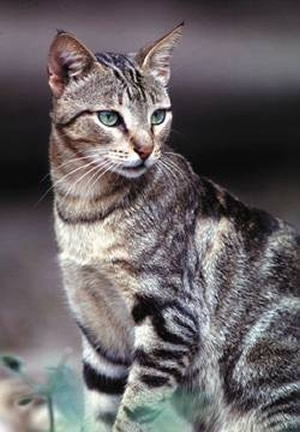Breed Standard
Head: Appears small compared to body. Wedge-shaped. Nearly flat top of the skull. High, well-defined cheekbones. Nose moderately long, with a gentle concave curve. Strong, broad chin. Well-defined whisker pads. No whisker pinch.
Eyes: Large, slightly almond-shaped, moderately spaced, slightly slanted toward the nose. Amber to light green. Outlined in the same color as the solid parts of the markings.
Body: Moderately long, svelte, very muscular. Solidly boned. Well-developed chest.
Paw: Long, svelte, and very muscular. Forelegs are shorter than hind legs. Oval paws.
Tail: Moderately long, thick at the base, tapering to the tip.
Coat: Short hair, shiny but not silky, lying flat against the body. Little or no undercoat. Recognized Color: brown blotched tabby, that is, brown or black marbled tabby with a somewhat darker base. The tip of the tail is always black. Each hair has alternating light and dark bands.
Fault: Head too Oriental in type. Stop too pronounced. Whisker pinch. Body too stocky and lacking elegance. Disqualify: white locket or white markings anywhere on the body except the nostrils, chin, and throat.
History
From the trees of Kenya Khadzonzos have long inhabited the forests of Kenya’s Sokoke district. Spending their time in trees, they are voracious insect hunters. In the 1970s, Jeni Slater, an Englishwoman living in Kenya, adopted a female cat and her kittens, the origin of the breed. Canadian native Gloria Moldrup, a friend of Slater, first brought two kittens back to Denmark, then began importing them regularly around 1980. All her cats came from Jeni Slater’s cattery. Moldrup started a breeding program with other breeders. In 1983, the breed was named the Sokoke. It was officially recognized first in Denmark in 1992, then in other countries. The F.I.Fe. approved it in 1993. Internationally, it received the name Sokoke. It is still extremely rare.
Behavior
This active, lively, independent cat is a very good climber and swimmer. He is sociable with other cats and with dogs. Gentle and affectionate, he makes a good companion. They tend to be vocal toward human keepers and other cats they cohabit with. They bond deeply to each other, as well as their owners. This trait makes re-homing harder for them, with a longer adjustment period expected in adult cats and older, already-bonded kittens. Weekly brushing is enough to maintain his coat.
Health
The Sokoke does best in a controlled environment, because of their limited resistance to common New World cat illnesses, often found in catteries and multi-cat homes. With recently published DNA data, it has been concluded that these cats, along with those of nearby Lamu Island, are part of the Asian group of domestic cats, and have Arabian wildcat genetic origins as well. As such it is a felid hybrid. The wildcat and the two domestic hybrids share regional and genetic similarities but are very different in coloration and structure when looked at closely.






